Current form 1992 Headquarters Minsk | Service branches ArmyAir Force Founded 1992 | |
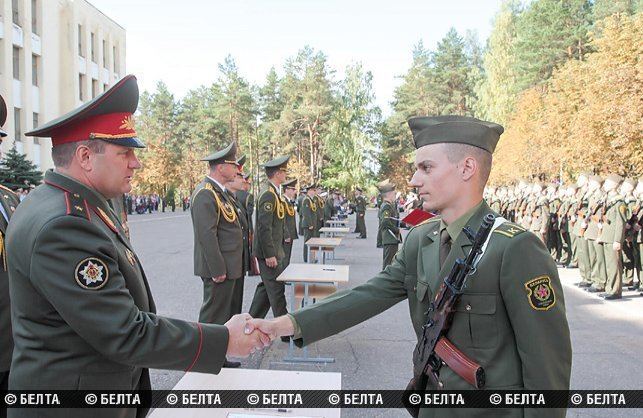 | ||
Minister of Defence Lieutenant-General Andrei Ravkov Chief of Defense Major-General Pyotr Tikhonovskiy Active personnel 62,000 (including 48,000 military personnel and 14,000 civilians in 2012) Budget 784.8 million USD (2012 est) Similar Belarusian Air Force, Chemical Corps, Russian Armed Forces, Luxembourg Army, Military of Moldova | ||
Armed forces of belarus
The Armed Forces of the Republic of Belarus (Belarusian: Узброеныя сілы Рэспублікі Беларусь – УС РБ, Uzbrojenyja sily Respubliki Bielaruś, Russian: Boopyжённыe cилы Pecпyблики Бeлapycь, Vooruzhennye sily Respubliki Belarus) consist of the Ground Forces and the Air and Air Defence Forces, all under the command of the Republic of Belarus Ministry of Defence. Being a landlocked country, Belarus has no navy.
Contents
- Armed forces of belarus
- History
- Structure
- Belarus Ground Forces
- Air Force and Air Defence Forces
- Internal Troops
- Manpower
- Equipment
- Air Defence
- Other
- References
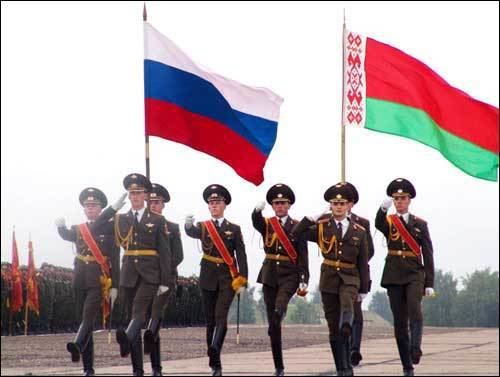
In 2007 the IISS estimated that personnel in the armed forces numbered 72,940 (IISS 2007), although a reduction to 60,000 was planned. Most soldiers are conscripts serving for a period 12 months (with higher education) or 18 month (without).

The previous Belarusian National Republic of March 1918 to 1919 did not have time to create armed forces in its brief existence, although attempts to create a military have been documented. The Republic of Belarus has conducted effective military reforms within the last decade which have reshaped its armed forces as a relatively effective force for a small state in somewhat difficult economic conditions.

The Ministry of Defence of the Republic of Belarus (Russian: Министерство обороны Республики Беларусь, Belarusian: Мiнiстэрства абароны Рэспублікі Беларусь) is the government organisation that is charged with the duties of raising and maintaining the Armed Forces of Belarus. The formation of the ministry began in 1992, after the events of 1991 in which the Soviet Union had effectively dissolved. Seven officers have served as Minister of Defence of Belarus: Petr Chaus, Pavel Kozlovskii, Anatoly Kostenko, Leonid Maltsev (1995–96), Colonel General Alexander Chumakov, a Russian officer, (1996–2001), Yuriy Zhadobin (ru:Жадобин, Юрий Викторович) (2009–2014), and Andrei Ravkov (2014-current).
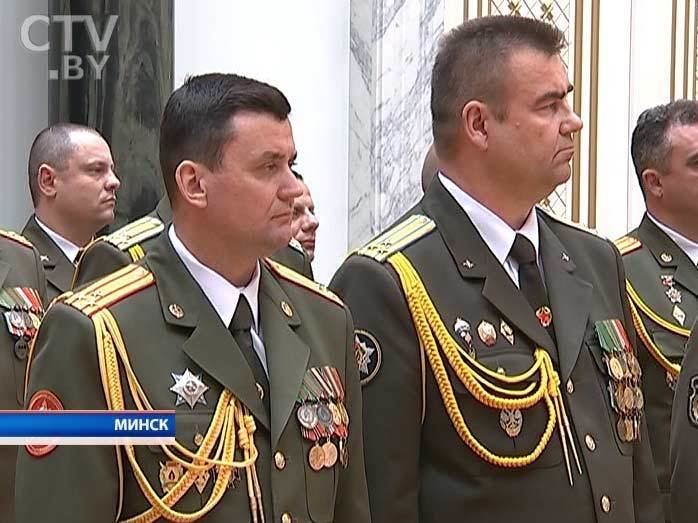
History
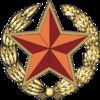
Until 1991 the Soviet Belorussian Military District comprised the 5th Guards Tank Army (HQ Bobruisk), the 7th Tank Army (HQ Borisov), the 28th Army (HQ Grodno), the 120th Guards Motor Rifle Division, the 72nd Guards United Training Center and logistical units and formations. In addition to these troops Belarus was host to centrally controlled formations, namely the 103rd Guards Airborne Division, the 38th Guards Airborne Brigade, the 11th Air Defence Corps of the 2nd Air Defence Army, the 26th Air Army and also units and formations of the Strategic Rocket Forces, Long Range Aviation, the Navy and special forces.
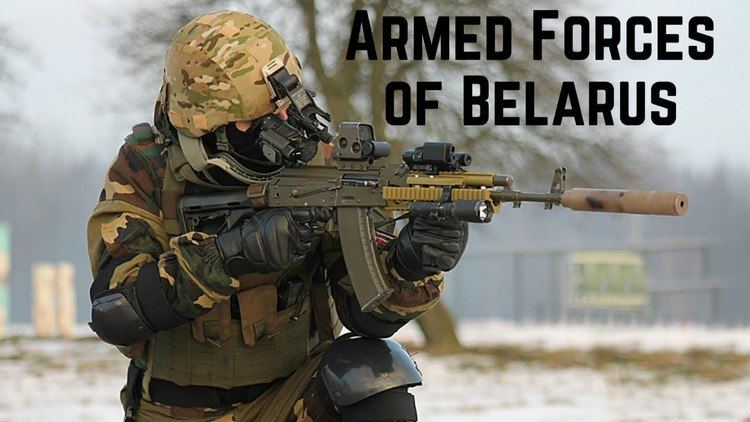
In late 1991 the 5th Guards Tank Army comprised the 30th Guards Motor Rifle Division, newly arrived from Czechoslovakia, and the 193rd Tank Division, plus two armament and equipment storage bases (the former 8th Guards and 29th Tank Divisions), and army troops. The 7th Tank Army comprised the 3rd Guards Tank Division, 34th, and 37th Guards Tank Divisions, plus army troops. The 28th Army comprised four divisions, one of which was a low-status mobilisation division. Also arriving from the Southern Group of Forces in Hungary was the 19th Guards Tank Division.

On September 20, 1991 the Supreme Soviet of Belarus passed resolution "On the formation of the Armed Forces of the Republic of Belarus" and on January 11, 1992 resolution "On the Armed Forces deployed in the territory of the Republic of Belarus." On March 18, 1992 the parliament passed resolution "On the Armed Forces of the Republic of Belarus" that bound the government "to start the formation of the Armed Forces of the Republic of Belarus as of March 20, 1992" and "to submit to the Supreme Soviet for approval the suggested structure of the Armed Forces, their size and order of their material and technical supplies".
On May 6, 1992 the Belorussian Military District was abolished. The Belarusian Ministry of Defence and the Main Staff were formed from its resources. The former first deputy commander and military district Chief of Staff, Lieutenant-General P P Kozlovskiy, was appointed Minister of Defence on 22 April 1992, taking over from acting Minister of Defence Colonel-General Petr Chaus.
On November 3, 1992, Belarus passed the law "On the Armed Forces of the Republic of Belarus" defining the status, structure and guiding principles of the Armed Forces. After the introduction of presidency the law was amended twice: on September 4, 1996 and on November 9, 1999 but on the whole the law retains its initial contents.
On January 1, 1993 all service personnel on Belarusian soil were required to either take an oath of loyalty to Belarus, or leave. This oath however did not alleviate concerns regarding loyalty to Russia in time of crisis, especially since nearly 50% of all military personnel were ethnically Russian at the end of 1992.
In June 1995, President Lushenko issued a decree on the Mobile Forces. By June 1996, they comprised a headquarters based in Vitebsk, two brigades drawn from the 103rd Guards Airborne Division, the 38th Independent Mobile Brigade (Brest, Belarus), an air transport regiment, and communications, logistics, and engineer units.
Membership in the Commonwealth of Independent States, as well as the 1996 treaty on the Union of Russia and Belarus and the Treaty of the Formation of a Union State in 1999, confirmed a close partnership with Russia. Much of the air defence system is integrated into the Russian air defence network, and in 2006 the two nations signed an agreement on the creation of a unified air defence system.
Structure
Belarus government websites say that the Ministry of Defence of the Republic of Belarus is supported by Central Command Support Elements and the General Staff of the Armed Forces. Combat Support Elements of the Armed Forces included Reconnaissance, Electronic Warfare, Signals, Engineer, NBC Defence, Navigation and Topography, and Maintenance organisations. Logistic Elements of the Armed Forces provided Material Support, Logistic Support, Medical Support, Veterinarian Support, and Military Construction.
In 1995 the Military Academy of Belarus was set up on the basis of two military educational institutions – the Minsk Air Defence and Rocket School of the Soviet Air Defence Forces and the Minsk Higher Military Command School. Its 10 departments train officers of 38 specialties for practically all arms of service. Also in 1995 it was given the status of a government institution of secondary special military education for young men.
Belarus Ground Forces
The Library of Congress said that in 1994 Belarus had ground forces of 52,500. They were organized into three corps headquarters, two motor divisions, one airborne division, the 51st Guards Artillery Division at Osipovichi, three mechanized divisions, one airborne brigade, three surface-to-surface missile brigades, two antitank brigades, one special duties brigade, and seven anti-aircraft missile brigades. Equipment included 3,108 main battle tanks (seventy-nine T-54, 639 T-55, 291 T-62, 299 T-64, eight T-80, and 1,800 T-72), 419 medium-range launchers, sixty surface to-surface missiles, and 350 surface-to-air missiles.
In 1993 the 7th Tank Army was reorganised as the 7th Army Corps. In 1994 the 7th Army Corps was redesignated as the 65th Army Corps, still located at Borisov.
By January 1, 1995, the composition of the Belarusian ground forces had changed. The Library of Congress estimated at the time that Ministry of Defence forces included the 103rd Guards Airborne Division and the 38th Separate Assault-Landing Brigade; the 28th Army Corps (Grodno Region and Brest Region), composed of headquarters at Grodno, the 6th Separate Mechanised Infantry Brigade, the 11th Guards Mechanised Infantry Brigade, the 50th Separate Mechanised Infantry Brigade, the Armament and Equipment base, and corps units (missile troops, antiaircraft, chemical and engineer troops, signals, and rear services); the 65th Army Corps (Minsk and Vitebsk Regions), composed of headquarters at Borisov, three armament and equipment bases, and corps units; and the 5th Guards Army Corps (Minsk and Mahilyow regions) made up of headquarters at Babruysk, the 30th Separate Motor Rifle Brigade, two Armament and Equipment bases, and corps units.
Actually, the 103rd Guards Airborne Division had been reorganized as Headquarters, Mobile Forces, in 1993. On 1 August 1996 the 51st Guards Artillery Division was reorganised as the 51st Guards Central Group of Artillery, still located at Osipovichi.
On 21 December 2001, a major reorganisation of the Ground Forces produced two operational-territorial commands, formed from two former corps headquarters. All Belarus ground forces were now grouped within these two commands, the Western Operational Command at Grodno, former from the previous 28th Army Corps, the former Soviet 28th Army, and the North Western Operational Command, the former 65th Army Corps, at Barysaw (Borisov).
Since about 2001, territorial defence forces, which as of 2002 number around 150,000, have been forming, organised into battalions, companies, and platoons spread across Belarus.
In 2007, the Land Forces consisted of 29,600 soldiers (6th Guards Mechanised Brigade (Grodno), 11th Guards Mechanized Brigade at Slonim, the 120th Guards Mechanised Brigade (Minsk), 38th and 103rd Mobile Brigades (organized similarly to Soviet airborne regiments, not all of them are equipped with BMD-1), 5th Spetsnaz Brigade (Maryina Horka), five artillery brigades and four regiments, two MRL regiments, 15th, 29th, 115th, 120th and 302nd SAM Brigades, two SSM brigades, two brigades and one regiment of engineers, 8th independent NBC Brigade, two signals brigades, 40th independent NBC battalion. Army equipment includes 1800 main battle tanks (MBT) and 2600 AFV/APC. The weapons and equipment storage bases include the 50th (Brest), 19th, 34th & 37th (former tank divisions), 3rd, and 28th (Baranovichi). Weapons storage bases that have been disbanded include the 29th, 30th, 193rd, and the storage base that used to be the 8th Guards Tank Division at Marina Gorka.
In 2012, it is reported that there are six mechanised brigades in the Ground Forces: three full-strength, the 6th (Grodno), 11th (Slonim), and 120th Guards Mechanised Brigade at Minsk. The others are at reduced strength, where there is one battalion, the 19th (Zaslonova), 37th, and 50th (Baranovichi).
Air Force and Air Defence Forces
In 2007 the Air Force and Air Defence Force of Belarus (AF & ADF) consisted of 18,170 personnel (two fighter/interceptor bases, four FGA/reconnaissance squadrons, one transport air base, training aircraft, and attack and support helicopters, SAM units). Air Force equipment included in 2004 260 fighter-ground attack/training aircraft and 80 attack helicopters. According to Belarus government websites, the Air Forces now have two commands, the Western Operational-Tactical Command and the North-Western Operational-Tactical Command.
The 61st and 927th Air Bases have now merged into the 61st (fighter) Air Base at Baranovichi, flying MiG-29s and Su-27s, and the 206th Air Base (Ross) has merged into the 116th Guards Assault Air Base at Lida, flying Su-25s.
Internal Troops
The Internal Troops were formed from the former Soviet Internal Troops after the collapse of the Soviet Union. They consist of three independent brigades and seven independent battalions (consecutively numbered). Among the Internal Troop formations is the 3rd Red Banner separate special purpose Brigade (V/Ch 3214, located in Minsk, in the district Uruchcha, "Uruchenskaya Brigade"). This brigade performs crowd control, combating terrorism tasks, and can assist border guards in case of complications. In addition, the brigade has been training for combined arms operations in the event of armed conflict. It was formed in the 1990s on the base of the 334th Regiment of the 120th 'Rogachev' Guards Motor Rifle Division.
Manpower
The Government Directive of 20 March 1992 ‘On the Establishment of the Armed Forces of the Republic of Belarus’ founded the Belarusian army. The Soviet troops of the BMD were smoothly converted into Belarusian military units. Yet one of the first tasks of the Belarusian government was a reduction in its numbers. 240,000 soldiers and officers were serving in the Belarusian Military District. By early 2013 the numbers of military personnel had been scaled down nearly fourfold since 1991. In February 2014, Belorusskaya Voyennaya Gazeta, the official publication of the Ministry of Defense revealed that the Belarusian Armed Forces contains about 59,500 personnel, including 46,000 soldiers and 13,000 civilians.
Equipment
The military forces of Belarus are exclusively armed with Soviet-era equipment inherited from the Soviet Union. Although large in numbers, some Western experts consider some of it outdated. The MBTs are of Russian type T-72, T-62, and T-55, the APCs and IFVs are of Russian type MT-LB, BMP-2, BMP-1, and the BMD-1, and Russian type trucks are the GAZ-66 and the KAMAZ-6560. The Air Force is equipped with MiG-29 fighters, Su-25 bombers, as well as Mi-8, Mi-24, and some old, Polish built Mi-2 helicopters. In December 2005, Belarus bought 10 L-39C jet trainer aircraft from the Ukraine, and plans have been announced to buy around 18 used Su-30K fighters that were originally sent to India for a time. In 2006, four batteries (divizions in Russian terminology; about 6 systems each) of S-300 anti-aircraft systems were acquired from Russia to reinforce the Joint CIS Air Defense System.
